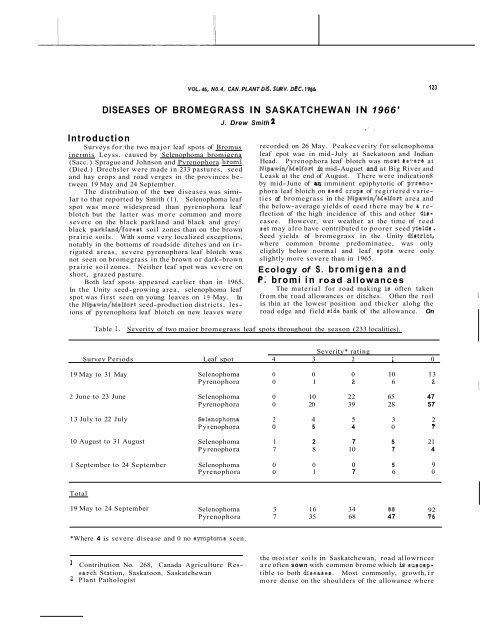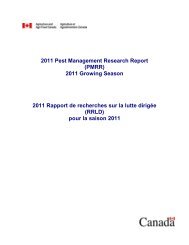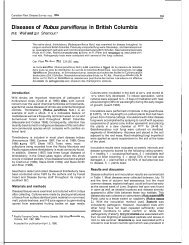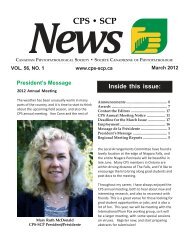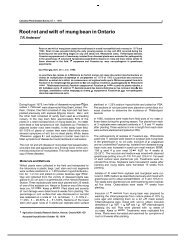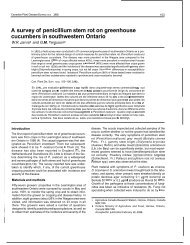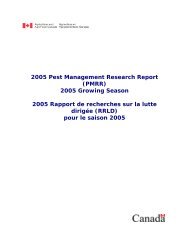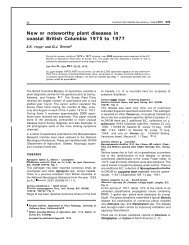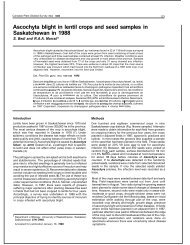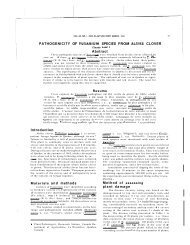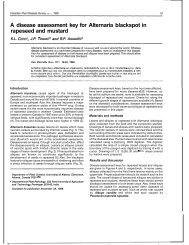J. DREW SMITH Diseases of bromegrass in Saskatchewan
J. DREW SMITH Diseases of bromegrass in Saskatchewan
J. DREW SMITH Diseases of bromegrass in Saskatchewan
Create successful ePaper yourself
Turn your PDF publications into a flip-book with our unique Google optimized e-Paper software.
VOL.46, N0.4, CAN. PLANT DIS. SURV. DEC. 1966<br />
DISEASES OF BROMEGRASS IN SASKATCHEWAN IN 1966'<br />
Introduction<br />
Surveys for the two major leaf spots <strong>of</strong> Bromus<br />
<strong>in</strong>ermis Leyss. caused by Selenophoma bromigena<br />
(Sacc. ) Sprague and Johnson and Pyrenophora .bromi<br />
(Died.) Drechsler were made <strong>in</strong> 233 pastures, seed<br />
and hay crops and road verges <strong>in</strong> the prov<strong>in</strong>ces be-<br />
tween 19 May and 24 September.<br />
The distribution <strong>of</strong> the two diseases was simi-<br />
lar to that reported by Smith (1). Selenophoma leaf<br />
spot was more widespread than pyrenophora leaf<br />
blotch but the latter was more common and more<br />
severe on the black parkland and black and grey/<br />
black parkland/forest soil zones than on the brown<br />
prairie soils. With some very localized exceptions,<br />
notably <strong>in</strong> the bottoms <strong>of</strong> roadside ditches and on ir-<br />
rigated areas, severe pyrenophora leaf blotch was<br />
not seen on <strong>bromegrass</strong> <strong>in</strong> the brown or dark-brown<br />
prairie soil zones. Neither leaf spot was severe on<br />
short, grazed pasture.<br />
Both leaf spots appeared earlier than <strong>in</strong> 1965.<br />
In the Unity seed-grow<strong>in</strong>g area, selenophoma leaf<br />
spot was first seen on young leaves on 19 May. In<br />
the Nipaw<strong>in</strong>/Melfort seed-production districts, les-<br />
ions <strong>of</strong> pyrenophora leaf blotch on new leaves were<br />
J. Drew Smith 2<br />
recorded on 26 May. Peakeeverity for selenophoma<br />
leaf epot wae <strong>in</strong> mid-July at Saekatoon and Indian<br />
Head. Pyrenophora leaf blotch was moot revere at<br />
Nipaw<strong>in</strong>/Melfort <strong>in</strong> mid-Auguet and at Big River and<br />
Leask at the end <strong>of</strong> August. There were <strong>in</strong>dication8<br />
by mid-June <strong>of</strong> an imm<strong>in</strong>ent epiphytotic <strong>of</strong> pyreno-<br />
phora leaf blotch on eeed crop8 <strong>of</strong> regirtered varie-<br />
ties <strong>of</strong> <strong>bromegrass</strong> <strong>in</strong> the Nipaw<strong>in</strong>/Melfort area and<br />
the below-average yields <strong>of</strong> eeed there may be a re-<br />
flection <strong>of</strong> the high <strong>in</strong>cidence <strong>of</strong> this and other dir-<br />
easee. However, wet weather at the time <strong>of</strong> reed<br />
set may alro have contributed to poorer seed yield6 .<br />
Seed yields <strong>of</strong> <strong>bromegrass</strong> <strong>in</strong> the Unity dietrict,<br />
where common brome predom<strong>in</strong>atee, was only<br />
elightly below normal and leaf spot6 were only<br />
slightly more severe than <strong>in</strong> 1965.<br />
Ecology <strong>of</strong> S. bromigena and<br />
P; bromi <strong>in</strong> road allowances<br />
The material for road mak<strong>in</strong>g ie <strong>of</strong>ten taken<br />
from the road allowances or ditches. Often the roil<br />
is th<strong>in</strong> at the lowest position and thicker alohg the<br />
road edge and field eide bank <strong>of</strong> the allowance. On<br />
Table 1. Severity <strong>of</strong> two major <strong>bromegrass</strong> leaf spots throughout the season (233 localities).<br />
Severity* rat<strong>in</strong>g<br />
Survey Periods Leaf spot 4 3 2 1 0<br />
19 May to 31 May<br />
2 June to 23 June<br />
13 July to 22 July<br />
10 August to 31 August<br />
Selenophoma 0 0 0 10 13<br />
Pyrenophora 0 1 a 6 a<br />
Se lenophoma 0 10 22 65 47<br />
Pyrenophora 0 20 39 28 57<br />
Selenophoma 2 4 5<br />
Pyr enopho ra 0 5 4<br />
123<br />
3 2<br />
0 7<br />
Selenophoma 1 2 7 5 21<br />
Pyr enopho ra 7 8 10 7 4<br />
1 September to 24 September Se lenophoma 0 0 0 5 9<br />
Pyrenophora 0 1 7 6 0<br />
Total<br />
19 May to 24 September Selenophoma 3 16 34<br />
Pyrenophora 7 35 68<br />
*Where 4 is severe disease and 0 no sym:ptoms seen.<br />
Contribution No. 268, Canada Agriculture Resthe<br />
moister soils <strong>in</strong> <strong>Saskatchewan</strong>, road allowrncer<br />
are <strong>of</strong>ten sown with common brome which is surcepearch<br />
Station, Saskatoon, <strong>Saskatchewan</strong> tible to both diseasee. Most commonly, growth, ir<br />
2 Plant Pathologist<br />
more dense on the shoulders <strong>of</strong> the allowance where<br />
88<br />
47<br />
92<br />
76
124 VOL. 46, NO. 4, CAN. PLANT' DIS. SURV. DEC. 1966<br />
there is greater top soil depth or higher soil fertili-<br />
ty than at its base. In spr<strong>in</strong>g, follow<strong>in</strong>g snow melt,<br />
and <strong>in</strong> wet weather, water <strong>of</strong>ten stands <strong>in</strong> the allow-<br />
ance base.<br />
In the dark brown and brown prairie soil zones<br />
the lowest portion <strong>of</strong> the road allowance is usually<br />
the place where p. bromi may be found, sometimes<br />
with S. bromigena. On the darker soils <strong>of</strong> the park-<br />
land and parkland forest belt it is <strong>of</strong>ten necessary to<br />
search the road allowance shoulder <strong>in</strong> the longer<br />
grass to f<strong>in</strong>d 5. bromigena. Rarely is p. bromi ab-<br />
sent from <strong>bromegrass</strong> <strong>in</strong> the road allowance bottom<br />
on darker soils dur<strong>in</strong>g the summer. Verge trim-<br />
m<strong>in</strong>g operations expose almost the whole pr<strong>of</strong>ile <strong>of</strong><br />
<strong>bromegrass</strong> stands and it is noticeable that where<br />
patches <strong>of</strong> lush growthoccur there selenophoma leaf<br />
spot is usually more severe than where growth is<br />
sparse and open.<br />
Results <strong>of</strong> <strong>in</strong>fection studies with 2. bromigena<br />
show that follow<strong>in</strong>g <strong>in</strong>oculation with conidial suspen-<br />
sions, a 4- to 5-day moist chamber <strong>in</strong>cubation is<br />
required to establish <strong>in</strong>fection. Heavy water<strong>in</strong>g <strong>of</strong><br />
<strong>in</strong>oculated plants reduces the amount <strong>of</strong> <strong>in</strong>fection as<br />
the <strong>in</strong>oculum is largely washed <strong>of</strong>f. On the other<br />
hand, <strong>in</strong>fection with p. bromi may be apparent 48<br />
hours after <strong>in</strong>oculation. One <strong>of</strong> the factors affect<strong>in</strong>g<br />
Figure 1. Sporotrichium leaf spot on bramus <strong>in</strong>ermis.<br />
Figure 2. Black node on brome gross culms<br />
Left - Ste<strong>in</strong> fracture<br />
Centre - External appearance<br />
Right - lnternol blacken<strong>in</strong>g<br />
distribution <strong>of</strong> the two diseases on <strong>bromegrass</strong> <strong>in</strong><br />
road allowances may be differences <strong>in</strong> density <strong>of</strong><br />
stand, The denser growth at the edges favours the<br />
ma<strong>in</strong>tenance <strong>of</strong> high humidity around the lower leaves<br />
for the longer <strong>in</strong>fection period required by S. bromi-<br />
E. At the allowance base, although there may be<br />
more moisture, with sparser growth there is less<br />
protection from spore "wash <strong>of</strong>f" dur<strong>in</strong>g prolonged<br />
ra<strong>in</strong>y periods.<br />
Effect <strong>of</strong> burn<strong>in</strong>g on P. bromi<br />
The severity <strong>of</strong> leaf spots was found to have been<br />
reduced by burn<strong>in</strong>g plant debris. At Leslie, a strip<br />
<strong>of</strong> an 80-acre field <strong>of</strong> commercial brome grown for<br />
seed failed to catch fire <strong>in</strong> the fall <strong>of</strong> 1965. In July<br />
1966, 100 plants taken at random from the unburnt<br />
strip had an average rat<strong>in</strong>g <strong>of</strong> 2.06 for pyrenophora<br />
leaf spot, on the 0-4 scale, and 100 plants from the<br />
burnt area had an average rat<strong>in</strong>g <strong>of</strong> 0.20. At Nipa-<br />
w<strong>in</strong>, 100 plants from an area <strong>in</strong> a seed crop <strong>of</strong><br />
'Carlton' which did not burn <strong>in</strong> the spr<strong>in</strong>g <strong>of</strong> 1966<br />
had an average rat<strong>in</strong>g <strong>of</strong> 1.82 for pyrenophora leaf<br />
spot and 100 from the surround<strong>in</strong>g burnt area had an<br />
average rat<strong>in</strong>g <strong>of</strong> 0.43.<br />
Other diseases<br />
Scald (RJhynchosporium secalis (Oud.) J. J. Da-<br />
vis) was first noted at the end <strong>of</strong> May and become<br />
severe <strong>in</strong> several locations by mid-August. The<br />
disease was as common and severe on brome on<br />
light prairie soils as on the black soils <strong>of</strong> the park-<br />
land.
,<br />
I<br />
Figure 3. Selective herbicide damage on brome grass.<br />
VOL.46, N0.4, CAN.PLANT DIS.SURV. DEC.1966<br />
The Sporotrichium isolated <strong>in</strong> 1965 <strong>in</strong> Saskatoon<br />
was associated with leaf spot symptoms (Fig. 1) <strong>in</strong><br />
13 locations widely scattered over the prov<strong>in</strong>ce from<br />
mid-August 1966. The spott<strong>in</strong>g was severe on a<br />
seed crop <strong>of</strong> the variety 'Saratoga' at Melfort on 18<br />
August and moderately severe on a seed crop <strong>of</strong> the<br />
variety 'Carlton' at Leask on 31 August.<br />
A condition referred to as "black node" became<br />
apparent <strong>in</strong> July at Saskatoon (Fig. 2). It was associated<br />
with abnormally thick and brittle culms <strong>in</strong><br />
some varieties, The disease appeared <strong>in</strong> seed crops<br />
<strong>in</strong> the Melfort area <strong>in</strong> August. Isolates from blackened<br />
nodes yielded pr<strong>in</strong>cipally Septoria and Fusar-<br />
- ium spp. The condition had no significant effect on<br />
stem or seed weight <strong>in</strong> the varieties 'Red Patch' and<br />
'S-6733', but <strong>in</strong>creased lodg<strong>in</strong>g. Although it was not<br />
possible to relate the condition to cultural or climatic<br />
factors <strong>in</strong> commercial crops, at Saskatoon thick<br />
tillers and abnormally brittle stems were associated<br />
<strong>in</strong> experimental plant<strong>in</strong>gs with selective herbicide<br />
damage. The herbicide concerned was a low volatility<br />
2,4-DB. This was severe (Fig. 3) <strong>in</strong> all 5 varieties<br />
<strong>in</strong> replicated field experiment.<br />
literature cited<br />
1. Smith, J. Drew. 1965. <strong>Diseases</strong> <strong>of</strong> brome-<br />
grass <strong>in</strong> <strong>Saskatchewan</strong> <strong>in</strong> 1965. Can. Plant<br />
Dis. Surv. 45: 118-119.<br />
125


